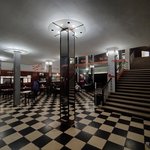Construction works began in 1935 so that the residential building could be opened in 1936. However, the cinema was not inaugurated until 1937. On www.budapest100.hu we found: "The cinema attracted the film and art world of the time to the tenement. Among its first residents were Elemér Lajtos, Béla Haich, Béla Saád, Lola Plesz and Irene Kékes. Elemér Lajtos was the first director of the Atrium Cinema, who made it his mission to make it the premier cinema for Hungarian films in Budapest. His determination can be traced in the cinema listings of the time: in the early years, the Atrium screened films such as 200 Fix a Month, Hotel Kikelet, The Man is Mad, The Borrowed Castle, The Case of the Nosty Boy..., Black Diamonds, and many more, featuring the most popular actors of the time. But Lajtos did not begin his career as a director at the Atrium: he served as a lieutenant in the First World War, retired after escaping from Siberia, and subsequently served as director of several Budapest cinemas. In 1923, he was director of the Corvin Film Theatre, in 1930 of La Scala, and from its opening he directed the Atrium." (translated by DeepL)
The building was hit by bombs during World War II, but was not destroyed. At the end of the war, part of the abattoir moved into the cinema and horses were slaughtered in the foyer. In 1947, everything went back to plan and the cinema was able to reopen. In 1950, the socialist government changed the name of the cinema, which was called 1 May until 1990. This was to honour the workers' movement.
In 1976, the interesting building was listed.
After being renamed Átrium, the cinema remained in use until 2001. Until 2012 it was not use and then transorfed into a theatre. When visiting Budapest in 2024, the exterior gave the impression that the former cinema area had been abandoned again.


















